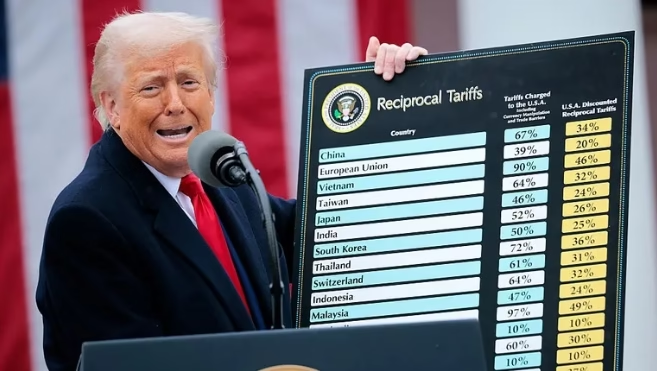Step 1: What is an HTS Code?
HTS (Harmonized Tariff Schedule) Code is a 10-digit classification number used by U.S. Customs to determine import duties and taxes.
The first 6 digits are universal (HS Code), while the last 4 digits are U.S.-specific.
Step 2: How to Find Your HTS Code
Method 1: Official U.S. HTS Code Lookup
Go to the USITC HTS Search Tool
Search by:
Product name (e.g., “LED light bulbs”)
Material (e.g., “plastic toys”)
Browse the category (e.g., Chapter 85 for electronics).
Find the 10-digit HTS code that matches your product.
Method 2: Ask Your Supplier
Chinese suppliers often know the HS Code (first 6 digits).
Confirm the full 10-digit HTS code using the USITC tool.
Method 3: Use a Freight Forwarder or Customs Broker
If unsure, a customs broker can classify your product properly (costs ~$50-$150).
Step 3: Calculate Duty & Tariffs
Once you have your HTS code, follow these steps:
1. Check the Duty Rate
Use the U.S. Customs Duty Calculator
Enter your HTS code to see the duty rate (%).
Example:
HTS Code 9405.40.80 (LED lamps) = 3.9% duty
HTS Code 6110.20.20 (Cotton sweaters) = 16.5% duty
2. Additional Fees
Section 301 Tariffs (China-Specific)
Many Chinese products have extra 7.5%–25% tariffs (check USTR’s List).
Merchandise Processing Fee (MPF) = 0.3464% of product value (min $27, max $539).
Harbor Maintenance Fee (HMF) = 0.125% of product value.
3. Example Calculation
Product Value: $10,000
HTS Duty Rate: 5%
Section 301 Tariff: 25%
Total Duty =
Base Duty: $10,000 × 5% = $500
301 Tariff: $10,000 × 25% = $2,500
MPF: $10,000 × 0.3464% = $34.64
Total Fees = $500 + $2,500 + $34.64 = $3,034.64
Step 4: How to Reduce Duties
Check for Exemptions
Some products qualify for GSP (Generalized System of Preferences) = 0% duty.
Consider Shipping from Non-China Countries (Vietnam, Malaysia, etc.) to avoid Section 301 tariffs.
Use a Customs Bonded Warehouse (delay duty payment until sale).
Best Tips for trump tariffs explained
✅ Always verify your HTS code (wrong codes = fines or delays).
✅ Ask suppliers for an HS code (helps narrow it down).
✅ Use a customs broker if importing high-value goods.
✅ Check Section 301 tariffs before ordering from China.
How to Quickly Calculate Import Duty from China (Using AI Like ChatGPT)
Importing from China? Avoid surprise fees by using AI tools (like ChatGPT) to instantly find HTS codes and calculate duties—saving you hours of manual research. Here’s how:
Step 1: Find Your HTS Code in Seconds (Using AI)
Instead of digging through tariff databases, ask AI:
“What is the HTS code for [product] imported into the U.S.?”
Example:
“HTS code for wireless earbuds from China?”
“HTS code for silicone kitchenware?”
✅ AI will suggest possible codes → Verify on USITC HTS Search.
Step 2: Calculate Duty & Tariffs Automatically
Ask AI:
“What is the duty rate for HTS [code] from China?”
Example:
“Duty rate for HTS 8517.62.00 (wireless earbuds)?”
“Total tariffs for HTS 3924.10.00 (plastic tableware)?”
✅ AI will estimate:
Base duty % (e.g., 3.9%)
Section 301 China tariffs (e.g., +25%)
Additional fees (MPF, HMF)
Step 3: Get a Total Cost Breakdown
Ask:
“Calculate total duty for $5,000 of HTS [code] from China.”
✅ AI response example:
“For $5,000 wireless earbuds (HTS 8517.62.00):
Base duty: 3.9% → $195
Section 301 tariff: 25% → $1,250
MPF fee: 0.3464% → $17.32
Total fees: $1,462.32″
Bonus: AI Tips to Reduce Costs
Ask:
“How to avoid Section 301 tariffs for [product]?”
(Answer: Ship via Vietnam/Malaysia, use GSP exemptions, etc.)
“Is there a free trade agreement for [product]?”
Why Need to HTS Code Lookup?
Here 2 very important reasons.
The first reason is that find right product Duty rate can help you save money (reduce tariffs ).
For example, you’re contemplating importing these products: both product look like an umbrella.
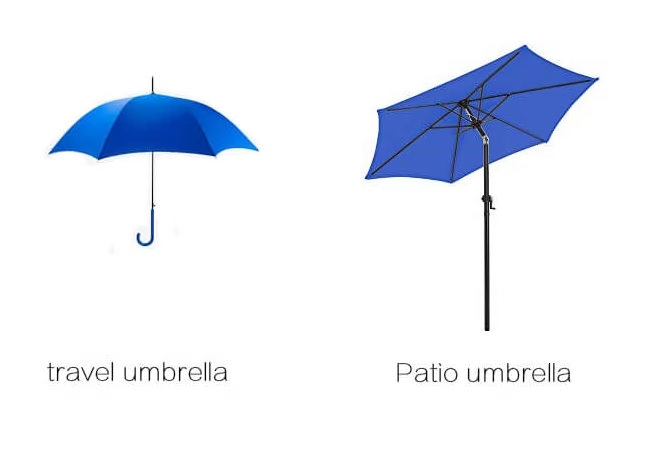
You’re right—two umbrellas might look similar, but tiny design changes can mean huge duty differences.
Example: Travel Umbrella vs. Patio Umbrella
Travel Umbrella (HTS 6601.99.00)
Duty: 0% (No extra tariffs)
Key Feature: Compact, no height adjustment
Patio Umbrella (HTS 6603.20.00)
Duty: 4.8% + 25% China Tariff
Key Feature: Adjustable height knob
Which One Would You Choose?
✅ Travel Umbrella = 0% Duty → Higher Profit
❌ Patio Umbrella = 29.8% Extra Cost → Eats into Margins
Why Knowing Your Exact Import Duty is a Legal Must (Avoid Costly Mistakes!)
As the Importer of Record, you—not your supplier—are 100% legally responsible for:
✔ Correct HTS code classification
✔ Accurate duty payment
✔ Truthful commercial invoice value
🚨 Big Risk: Suppliers Offering “DDP Shipping” with Underdeclared Value
Some suppliers lower the invoice value to “save you duty.” This is dangerous!
Customs audits can catch discrepancies.
You (not the supplier) face fines, shipment delays, or even legal trouble.
Example:
True Product Value: $10,000
Supplier Declares: $5,000 (to “reduce duty”)
Customs Penalty: Up to 40% of undervalued amount + back duties
3 Fees You Must Pay to Clear Customs
Import Duty (% based on HTS code)
Section 301 Tariffs (if importing from China, +7.5%–25%)
Customs Processing Fees
MPF (Merchandise Processing Fee): 0.3464% of value
HMF (Harbor Maintenance Fee): 0.125% of value
How to Protect Yourself
✅ Always demand a truthful commercial invoice (no underdeclaring!).
✅ Double-check the HTS code (use AI or the USITC Database).
✅ Ask suppliers for a pre-shipment duty estimate (avoid surprises).
Ignorance isn’t an excuse—customs won’t forgive mistakes. Stay compliant, save money, and sleep easy!
How Much Can You Spend Without Paying Duty?
suppose I’m getting a customized sample from the supplier with value $500. Do I need to pay for Duty?
The answer is: NO
Because of the declared value is less than $800, the Duty is free. If your commercial invoice value is over $800, you need to pay for the Duty. –cancelled 2025-05-02
To determine your duty rate, you need to know your HTS code which I’m gonna show you how to do a HTS code lookup.
Two additional Duty fees you need to be aware
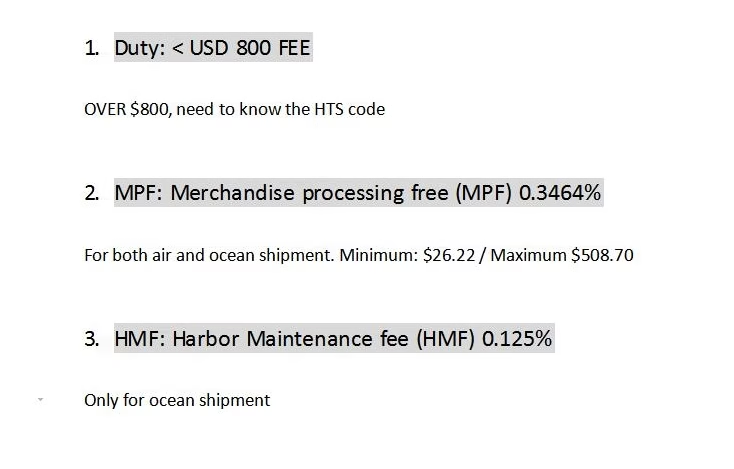
Understanding U.S. Import Fees & HTS/HS Codes
1. Key Import Fees You’ll Pay
When importing into the U.S., your total duty cost includes:
✅ Merchandise Processing Fee (MPF)
Rate: 0.3464% of shipment value
Applies to: Air & Ocean shipments
Minimum: $26 (if calculated fee < $26)
Maximum Cap: $508 (no matter how high the value)
✅ Harbor Maintenance Fee (HMF)
Rate: 0.125% of shipment value
Applies to: Ocean shipments only (not air freight)
No minimum/maximum
➕ Regular Duty Rate (Based on HTS code)
➕ Section 301 Tariffs (If importing from China, +7.5%–25%)
🔹 Example Calculation:
Product Value: $10,000
Duty Rate (HTS): 5% → $500
MPF (0.3464%): $34.64
HMF (0.125%, ocean only): $12.50
Total Fees: $500 + $34.64 + $12.50 = $547.14
2. The Difference Between HS Code & HTS Code
Many importers get confused—here’s the simple breakdown:
| HS Code | HTS Code | |
| Digits | 6 digits (global standard) | 10 digits (U.S.-specific) |
| Used By | 200+ countries (WCO) | United States (USITC) |
| Purpose | Basic product classification | Full U.S. duty calculation |
| Example | 9405.40 (Umbrellas | 9405.40.80 (U.S. tariff details) |
Why Does This Matter?
Your Chinese supplier gives you a 6-digit HS code (global standard).
But the U.S. requires a 10-digit HTS code for customs clearance.
The last 4 digits determine your exact duty rate—so always verify!
🔹 How to Find Your HTS Code:
Use the USITC Official HTS Lookup
Or ask AI tools (e.g., *”What’s the 10-digit HTS code for [product]?”*)
Key Takeaway
✔ MPF & HMF are small but mandatory fees—factor them into costs.
✔ Never rely only on the supplier’s HS code—convert it to a U.S. HTS code.
✔ A tiny code difference = big duty changes (e.g., 0% vs. 25% tariffs).
Let’s take a look at an example:
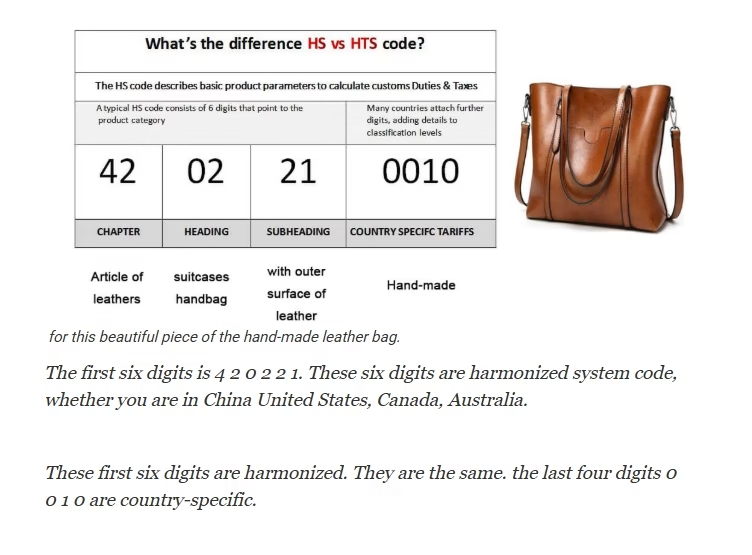
Example for HTS code means:
Now, we’re gonna break down the first six digits. So you are familiar with chapter hiding and the Subheading.
The first two digits represent the chapter name. In our case, our handbag is made of leather. So it belongs to chapter 42—everything made of leather.
The second two digits represent the heading. The heading further classified if this product is a trunk or suitcase or handbag made of leather. In our case, we are a hand back. So it belongs to hiding 02.
The 3rd two digits represent the Subheading. Subheading further specifies if this handbag has the outer surface made of leather.
Yes, we are made of leather. So our first sixth harmonized code is 420221.
Now, the last four digits are country-specific. If this handbag is hand made, then the classification is 0010. For u.s. Importers, it is important that you know your specific HTS code.
How to Do a HTS Code Lookup?
Now we’re gonna do a live search on the HTS code that we picked out for our travel umbrella and the garden umbrella
The first step is to find the chapter and the heading (first 4 digits).
there are four ways to find our HTS code chapter and heading:
How to Quickly Find Your HTS Code
The International Trade Commission (ITC) regulates U.S. HTS codes. While you could ask suppliers or freight forwarders, that takes time. Here’s a faster method:
Start with a Google Search
Example search: “umbrella HTS code”
First result shows: 6601 (this gives us the first 4 digits)
Verify in the Official Database
Go to USITC HTS Search
Enter the partial code (like 6601) to find the complete 10-digit classification
Understand What You’re Seeing
The first 6 digits = Global HS Code
Last 4 digits = U.S.-specific classification
Example: 6601.XX.XX (where XX are the U.S.-specific digits)
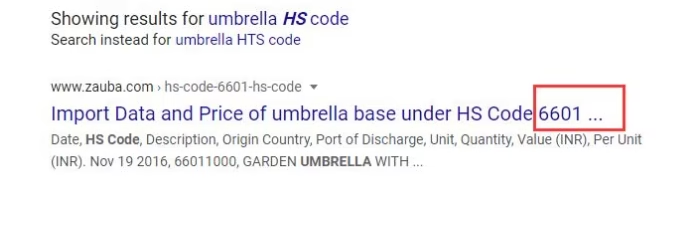
So I’m gonna use as the 6601 as a point of reference, and then I’m going to head over to the ITC website, and type in umbrella and just to see what the database is gonna show us.
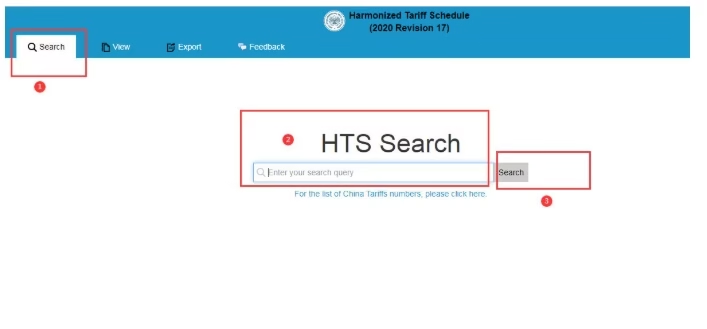
Smart HTS Code Lookup Method
When searching for umbrella classifications, both Google and the official USITC database consistently show results beginning with 6601 – the umbrella category’s chapter number. What makes this process efficient is how the system automatically highlights the keyword “umbrella” in all relevant descriptions.
This highlighting feature lets you quickly:
Scan for matching product descriptions
Identify the most accurate HTS code
Verify classification details with precision
The visual emphasis on your search term (“umbrella”) creates an intuitive verification process, ensuring you select the code that truly matches your specific product type within the broader 6601 category.
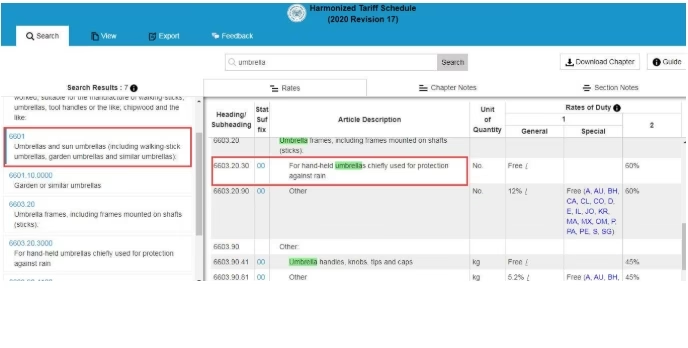
Pro Tip for Accurate HTS Classification
The secret to finding the right HTS code lies in understanding three key product attributes:
Material construction
Performance characteristics
Primary function
For example, let’s examine two umbrella types:
Travel Umbrella (6603.20.30)
Description: “Handheld umbrellas chiefly used for protection against rain”
Perfect match for our compact travel model
Duty Rate: 0% (Free)
Patio/Garden Umbrella (6601.10.00)
Designed for outdoor stationary use
Duty Rate: 6.5%
How Do I Know if I Need to Pay Additional Tariffs?
Find the tariff percentage.
We said our garden umbrella is Duty 6.5%/_. Except behind the 6.5%, there is a slash, and there’s an underscore.
When you see this sign “/_ ” slash underscore, that means there are additional Tariffs attached to the HTS code you are researching.
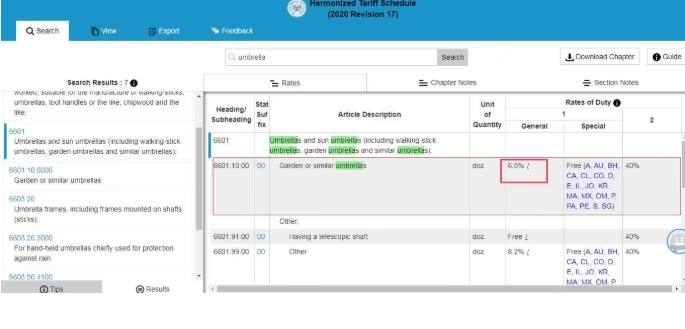
there are 4 tariffs lists:
LIST 1 25% in effect since 2018
LIST 2 25% in effect since 2018
LIST 3 25% in effect since 2018
LIST 4a 7.5 % new in effect since 2020.02.14
LIST 4b 15% The tariff was suspended Until Further Notice
So how do you know whether your product is subject to tariffs? I’ll show you a shortcut right now.
This link is your shortcut link. Through this link, you can quickly find out if your products have any tariff attached to it.
All you have to do is to go back to the HTS code that we say has a 6.5% and the slash underscore here. This is our umbrella that we wanted to sell.
Just click on this link copy and paste your HTS code, then you will be able to find your additional tariffs in addition to your regular Duty.
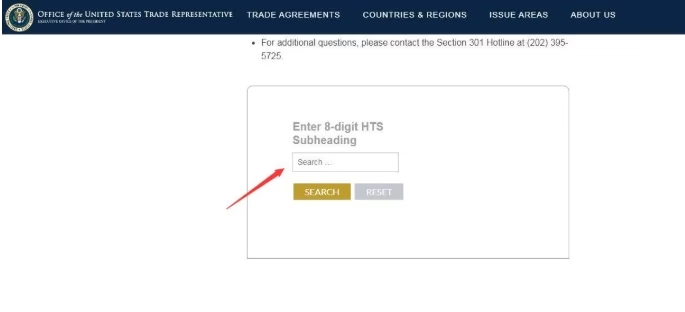
So we copy this 6601. 10. 00 and paste over to this website, and then we hit on search as you can see:
(List 4B) $300 Billion Tariff Action, which means it means no additional tariff right now.
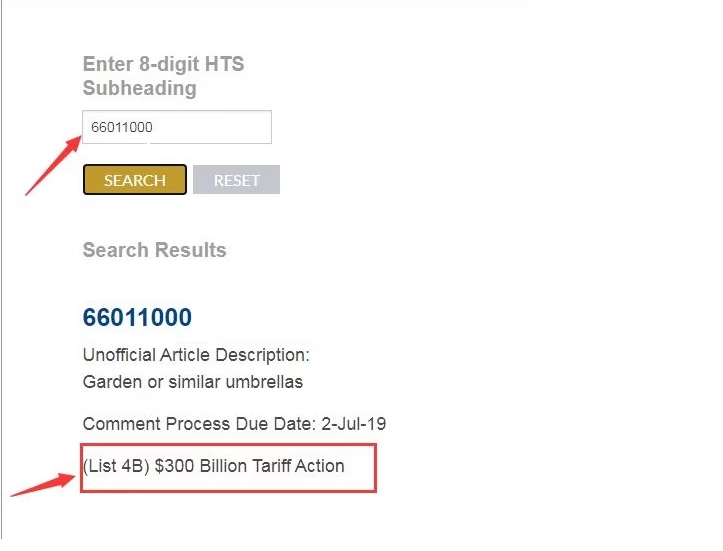
Now, you know both of your Duty and tariff percentage all you have to do is to calculate how much Duty to you owe.
Step-by-Step Guide to Calculate Customs Duty
Let’s use garden umbrellas (HTS 6601.10.00) as our example:
1.Create a Simple Calculation Sheet (Excel/Google Sheets)
Column A: Quantity
Column B: Unit Price ($)
Column C: Total Value (A×B) = Commercial Invoice Value
2.Duty Calculation
Duty Rate: 6.5% of Commercial Invoice Value
Example: $10,000 order × 6.5% = $650 duty
3.Additional Required Fees
Merchandise Processing Fee (MPF): 0.3464% (min $26, max $508)
Harbor Maintenance Fee (HMF): 0.125% (ocean shipments only)
4.Important Compliance Note
Never under-declare values to reduce duty
If audited: You’ll pay full duty + penalties (40-80% of underpaid amount)
5.Total Customs Payment
= (Commercial Value × Duty Rate) + MPF + HMF
Example Calculation:
Order Value: $10,000
Base Duty (6.5%): $650
MPF (0.3464%): $34.64
HMF (0.125%): $12.50
Total Due: $697.14
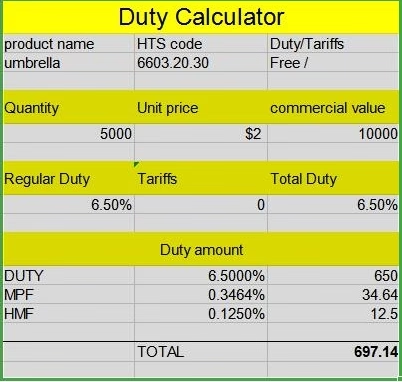
So all is $697.14 if you are buying 5000 handlebars at $2 per piece.
By the way, there are two more columns on the HTS code lookup website I want you to be familiar with, so you are not confused like many people.
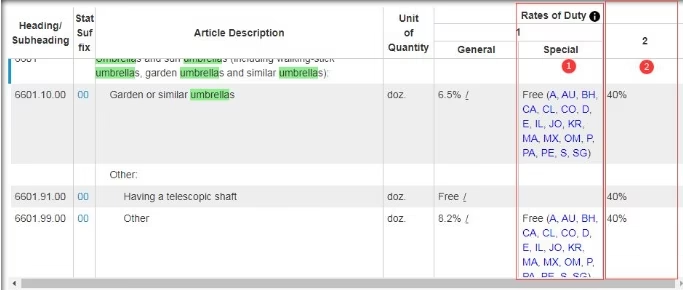
- Determine Base Duty Rate
- Find your product’s regular duty rate by checking its HTS code
- Special rate countries (Column 1) enjoy free trade agreements
- Example: Imports from Mexico/Australia often qualify for 0% duty
- Restricted countries (Column 2) face highest tariffs
- Applies to Cuba and North Korea imports
- Check Additional Tariffs
- Verify if your HTS code appears on any of the four special tariff lists
- Common additions:
- Section 301 China tariffs (+7.5%-25%)
- Anti-dumping/countervailing duties
- Calculate Final Amount
- Use this simple formula:
(Commercial Invoice Value × Duty Rate) + MPF + HMF
Import Duty Calculate Tool:
open AI, Chatgpt…
USA customs clearance’s HTS code lookup tool:
The official website of the U.S. tax rate query is: https://hts.usitc.gov/.
The query method is very simple, just input HTS CODE. From China to the United States, and check General. We have already talked about the detailed method above.
How to calculate Japan’s import tax rate according to HS CODE
official website: https://www.customs.go.jp/english/tariff/2019_4/index.htm
Instructions:
1. Select the corresponding code according to the chapter
2. Check the corresponding tax rate in the WTO column, which is China’s
How to calculate Russia’s import tax rate based on HS CODE
official website:
http://www.russian-customs.org/legislation/tariff/index.html
Instructions:
1. Search for Russia by chapter
2. downloaded a WORD file, which contains the import tax rate
How to calculate Canada’s import tax rate according to HS CODE
official website:
http://www.cbsa-asfc.gc.ca/trade-commerce/tariff-tarif/
Instructions:
1. Choose /Year
2. Select Customs Tariff by chapter according to the chapter
3. Choose html
4. Check the tax rate
How to check the import duties of EU countries according to HS CODE
The import tariffs of EU countries are uniform, including these countries:
The official website for inquiring about tariffs:
https://ec.europa.eu/taxation_customs/dds2/taric/taric_consultation.jsp?Lang=en
Instructions:
1. confirm the accuracy of the HS code
2. Re-query the tax rate corresponding to the code
3. As shown in the figure below, the third-country is the tax rate suitable for China.
How to check the import tariffs of FTA countries
Many countries have signed free trade agreements with China, and there are tariff preferences. The specific countries are as follows:
Maldives, Georgia, Australia, South Korea, Switzerland, Iceland, Costa Rica, Peru, Singapore, New Zealand, Chile, Pakistan, ASEAN (Brunei, Cambodia, Indonesia, Laos, Malaysia, Myanmar, Philippines, Singapore, Thailand, Vietnam)
search website:
http://fta.mofcom.gov.cn/ftanew/taxSearch.shtml
Query method:
1. Choose a country and click to search
2. View the results
How to check the import tariffs of other 88 countries
The Ministry of Commerce China has a universal query website:
http://wmsw.mofcom.gov.cn/wmsw/
Although the update speed may not be as fast as the official website, it is also very good. It can find 88 countries/regions import and export taxes and fees; 76 export commodity reports; 48 countries/regions regulatory conditions; 55 countries/regions tax calculation.
Trump’s Tariff Policies: Key Impacts on Canada & China
The Trump administration’s trade policies notably imposed 25% tariffs on certain Canadian goods, particularly aluminum and steel, as part of broader protectionist measures. While initially lifted, threats of reimposition lingered, creating uncertainty for cross-border trade.
Meanwhile, the U.S.-China trade war saw aggressive tariffs, including 25% duties on $250B+ of Chinese imports, prompting retaliatory tariffs from China on U.S. agricultural and manufactured goods. These measures disrupted global supply chains, incentivized reshoring, and fueled negotiations for the “Phase One” deal.
Takeaway: Trump’s tariffs prioritized U.S. industry but strained alliances with Canada and escalated tensions with China, leaving lasting trade policy debates.

